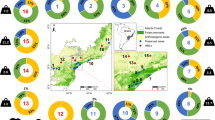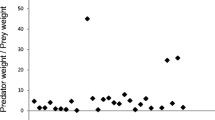Summary
The puma (Felis concolor) has the most extensive range of any terrestrial mammal in the Western Hemisphere, covering over 100° latitude. Food habits of different puma subspecies vary with latitude. Subspecies from temperate habitats generally eat larger prey and specialize on a smaller number of prey taxa, whereas, in tropical habitats, they prey on smaller, more varied prey. In North America, ungulates (primarily deer) represented 68% of the puma's diet by frequency of occurrence. Mean weight of vertebrate prey (MWVP) was positively correlated (r=0.875) with puma body weight and inversely correlated (r=-0.836) with food niche breadth in all America. In general, MWVP was lower in areas closer to the Equator. Patterns of puma prey selection are probably influenced by prey availability and vulnerability, habitat characteristics, and potential competition from the jaguar (Panthera onca).
Similar content being viewed by others
References
Ackerman BB, Lindzey FG, Hemker TP (1984) Cougar food habits in southern Utah. J Wildl Manage 48:147–155
Anderson AE (1983) A critical review of literature on puma (Felis concolor). Colorado Division of Wildlife Spec Rep 54
Bertram BCR (1982) Leopard ecology as studied by radio tracking. Symp Zool Soc, London 49:341–352
Bothma JDuP, Le Riche EAN (1986) Prey preference and hunting efficiency of the Kalahari desert leopard. In: Miller SD, Everett DD (eds) Cats of the World: Biology, Conservation, and Management. National Wildlife Federation, Washington, D.C., pp 406–412
Colwell RR, Futuyma DJ (1971) On the measuement of niche breadth and overlap. Ecology 52:567–572
Courtin SL, Pacheco NV, Eldridge WD (1980) Observaciones de alimentación, movimientos y preferencias de habitat del puma en el Islote Rupanco. Medio Ambiente (Chile) 4:50–55
Currier MJP (1983) Felis concolor. Mamm Species 200:1–7
Dayan T, Simberloff D, Tchernov E, Yoram Y (1989) Inter-and intraspecific character displacement in mustelids. Ecology 70:1526–1539
Dixon J (1925) Food predilections of predatory and furbearing mammals. J Mammal 6:34–46
Eisenberg JF (1981) The mammalian radiations: ecology, behavior, and evolution. University of Chicago Press, Chicago
Emmons LH (1987) Comparative feeding ecology of felids in a neotropical rainforest. Behav Ecol Sociobiol 20:271–283
Gittleman JL (1985) Carnivore body size: ecological and taxonomic correlates. Oecologia 67:540–554
Hibben FC (1937) A preliminary study of the mountain lion (Felis oregonensis sp.). University of New Mexico Agric Stn Bull 318:1–59
Honacki JH, Kinman KE, Koeppl JW (eds) (1982) Mammal species of the world. A taxonomic and geographic reference. Allen Press, Inc. and the Association of Systematics Collections, Lawrence, Kansas
Iriarte JA (1988) Feeding ecology of Patagonia puma (Felis concolor patagonica) in Torres del Paine National Park, Chile. M.A. Thesis, University of Florida, Gainesville, Florida
Iriarte JA, Johnson WE, Franklin WL, Johnson KA. Feeding ecology of the Patagonia puma in southern Chile
King CM (1989) The advantages and disadvantages of small size to weasels, Mustela species. In: Gittleman JL (ed) Carnivore behavior ecology and evolution. Cornell University Press, pp 302–334
Kurten B (1973) Geographic variation in size in the puma (Felis concolor). Commentat Biol Soc Sci Fennica 63:1–8
Levins R (1968) Evolution in changing environments. Princeton University Press, Princeton, N.J.
Maehr DS, Land ED, Roof JC, McCown JW (1989) Early maternal behavior in the Florida panther. Am Midl Nat 122:34–43
Maehr DS, Belden RC, Land ED, Wilkins L (1990) Food habits of panthers in Southwest Florida. J Wildl Manage (in press)
McBride RT (1976) The status and ecology of the mountain lion (Felis concolor stanleyana) of the Texas-Mexico border. M.S. Thesis, Sul Ross State University, Alpine, Texas
McNab BK (1971) On the ecologial significance of Bergmann's rule. Ecology 52:845–854
Mondolfi E, Hoogesteijn R (1986) Notes on the biology and status of the jaguar in Venezuela. In: Miller SD, Everett DD (eds) Cats of the World: Biology, Conservation, and Management. National Wildlife Federation, Washington, D.C., pp 125–146
Pianka ER (1973) The structure of lizard communities. Ann Rev Ecol Syst 4:53–74
Pimm SL, Gittleman JL (1990) Carnivores and ecologists on the road to Damascus. Trends Ecol Evol 5:70–73
Rabinowitz AR, Nottingham BG (1986) Ecology and behaviour of the jaguar (Panthera onca) in Belize, Central America. J Zool (Lond) 210:149–159
Ralls K, Harvey PH (1985) Geographic variation in size and sexual dimorphism of North American weasels. Biol J Linn Soc 25:119–167
Robinette WL, Gashwiler JS, Morris OW (1959) Food habits of the cougar in Utah and Nevada. J Wildl Manage 23:261–273
Roelke ME (1987) Florida panther biomedical investigation. E-1-11 Annual performance report. Florida Game and Fresh Water Fish Comm. Tallahassee, FL pp 111
Roelke ME, Jacobson ER, Kollias GV, Forrester DJ (1986) Medical management and biomedical findings on the Florida Panther, Felis concolor coryi. Annual report, Florida Panther Research Team, Florida Game and Fresh Water Fish Commission
Rosenzweig ML (1966) Community structure in sympatric carnivora. J Mammal 47:602–612
Schaller GB (1983) Mammals and their biomass on a Brazilian ranch. Arq Zool (Sao Paulo) 31:1–36
Schaller GB, Crawshaw PG Jr (1980) Movement patterns of jaguar. Biotropica 12:161–168
Schaller GB, Vasconcelos JMC (1978) Jaguar predation on capybara. Z Säugetierk 43:296–301
Schoener GB (1969) Models of optimal size for solitary predators. Am Nat 103:277–313
Seidensticker JC (1976) On the ecological separation between tigers and leopards. Biotropica 8:225–234
Spalding DJ, Lesowski J (1971) Winter food of the cougar in southcentral British Columbia. J Wildl Manage 35:378–381
Sunquist ME, Sunquist FC (1989) Ecological constraints on predation by large felids. In: Gittleman JL (ed) Carnivore behavior ecology and evolution. Cornell University Press, pp 283–301
Toweill E, Meslow EC (1977) Food habits of cougar in Oregon. J Wildl Manage 41:576–578
Vezina AF (1985) Empirical relationships between predator and prey size among terrestrial vertebrate predators. Oecologia 67:555–565
Wilson P (1984) Puma predation on guanacos in Torres del Paine National Park, Chile. Mammalia 48(4):515–522
Yàñez J, Cardenas JC, Gezelle P, Jaksic FM (1986) Food habits of the southernmost mountain lions (Felis concolor) in South America: natural versus livestocked range. J Mammal 67:604–606
Author information
Authors and Affiliations
Rights and permissions
About this article
Cite this article
Iriarte, J.A., Franklin, W.L., Johnson, W.E. et al. Biogeographic variation of food habits and body size of the America puma. Oecologia 85, 185–190 (1990). https://doi.org/10.1007/BF00319400
Received:
Accepted:
Issue Date:
DOI: https://doi.org/10.1007/BF00319400




